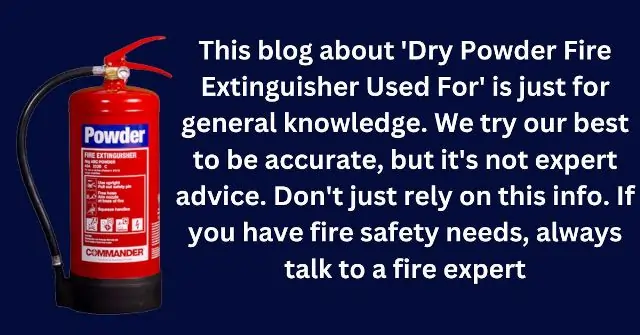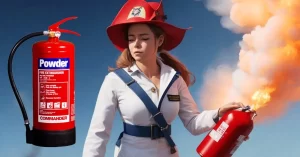Table of Contents
Dry Powder Fire Extinguisher Used For
Fire safety is paramount in any setting, and understanding the tools at our disposal is the first step towards ensuring protection. The dry powder fire extinguisher is among the most versatile tools in our fire safety arsenal. This extinguisher can put out Class A, B, and C fires. So, many people call it the ABC fire extinguisher. That’s why many refer to it as the ABC fire extinguisher. But did you know some also call it a dry chemical fire extinguisher?
With its wide-ranging applications, the dry powder fire extinguisher is an essential piece of equipment. You’ll frequently spot these in garage forecourts, commercial boiler rooms, and expansive workshops. Many businesses like these extinguishers because they work well and are flexible. We need to know when and how to use them. This guide will help us understand dry powder fire extinguishers better.
We’ll discuss the fires it can combat and those it shouldn’t tackle. Further, we’ll explore the mechanics behind its operation, pinpointing the locations that would benefit the most from its presence. By the end, you’ll also learn how to identify this extinguisher amidst others quickly.
Equip yourself with the proper knowledge and ensure safety always comes first. Let’s delve in!
Understanding the Uses of Dry Powder Fire Extinguishers
A powder fire extinguisher works on fires from solid materials (Class A), liquids (Class B), and gases (Class C). You can also use it for electrical fires below 1000v without getting an electric shock. But if you’re near things like kitchen appliances or heaters, it’s good also to have CO2 extinguishers. Don’t use powder extinguishers for equipment over 1000v or computers because it might damage them. Also, it doesn’t work on cooking oil fires, so it’s unsuitable for Class F fires.
In summary, while the powder fire extinguisher is a versatile tool, knowing its limits is essential. Due to potential damage, there may be better choices than relying solely on electrical settings or places with tech equipment. Moreover, in areas where cooking oil fires could occur, like kitchens, having an alternative means of fighting fires is crucial. This is because the high burning temperatures of cooking oils make them resistant to the powder’s effects. Therefore, always consider the specific risks in each area and equip it with the right fire-fighting tools. It’s not only about stopping fires but doing it safely without harm. Knowing what to do and being ready can help in emergencies.
Unveiling the Mechanics of Powder Fire Extinguishers
A powder fire extinguisher is essential in fire safety, but how exactly does it operate? The key lies in its extinguishing agent. This extinguisher releases a powder that acts swiftly on the flames when activated. This powder envelops the fire, effectively creating a ‘blanket’ that deprives the fire of its crucial fuel: oxygen. By cutting off the oxygen supply, the powder ensures that the fire gets suffocated and eventually extinguished.
However, there’s an important aspect to consider. Unlike other extinguishers, the powder variant doesn’t have a cooling effect on the flames. Why is this significant? Cooling is an essential factor in ensuring that a fire doesn’t reignite. Since the powder extinguisher doesn’t inherently lower the temperature of the burning material, there remains a slight chance that the fire might flare up again.
While the powder fire extinguisher effectively stifles fires, it’s essential to remain vigilant after its application. The potential for re-ignition, although small, necessitates that users monitor the affected area closely for any signs of resurgence. Being aware of the strengths and limitations of this tool can guide users in ensuring optimal fire safety.
“Recognizing a Powder Fire Extinguisher: Key Features”
Being safe from fires means using the right tools. Choose the wrong extinguisher, and it can be a problem. So, how can you find a powder fire extinguisher?
Check for a blue label. If it has “Powder” written on it, that’s your sign! This blue mark is easy to notice, even when moving fast.
There’s also a helpful hint. Look above the extinguisher for a sign – that’s its ID. This sign tells more, like which fires it works on and which it doesn’t. This way, you’ll know if it’s right for the job.
In short, a powder fire extinguisher has a blue tag and an info sign. It’s good to know these signs; they can be lifesavers in urgent times.
Where Should You Place Powder Fire Extinguishers?
The efficacy of a fire extinguisher largely depends on its strategic placement. One of the versatile types, the powder fire extinguisher, offers a broad range of applications, but it’s essential to position it in suitable locations for maximum effectiveness.
Workshops are an evident choice for these extinguishers. A fire can take on multiple forms, given the variety of materials and machinery. Garage forecourts, where fuels and lubricants are prevalent, also benefit from powder fire extinguishers, as these substances are flammable and pose significant risks.
Construction sites are another prime location with their mix of electrical equipment, combustible materials, and often open flames. Fires here can escalate quickly, and a suitable extinguisher is crucial.
Another critical application for powder fire extinguishers is vehicles, especially those carrying or transporting flammable substances. Fuel tankers, in particular, are high-risk zones where a small ignition can lead to catastrophic results. A powder extinguisher ensures that fires involving flammable liquids and gases can be addressed swiftly.
However, it’s essential to note the limitations of powder fire extinguishers. They might not be the best fit for enclosed spaces. When activated, the powder can fill the air, making it hard to see and breathe. This dispersion poses health risks, especially when inhaled. Furthermore, the cleanup process can be extensive post-use due to the residual powder left behind.
In conclusion, while powder fire extinguishers are invaluable, understanding their optimal locations and limitations is critical to maximizing their benefits and ensuring safety.
How to Use a Powder Fire Extinguisher
“Guidelines on Properly Operating a Powder Fire Extinguisher”
Ensuring safety during a fire emergency hinges on having the right tools and using them correctly. The powder fire extinguisher, known for its versatility, is a standard firefighting tool. But how should one operate it efficiently and safely during an emergency?
1. Assess the Situation: Always ensure your safety before extinguishing a fire. If the fire is too large or rapidly spreading, it’s best to evacuate and call professional firefighters.
2. Position Yourself: Stand safely, ideally 6-8 feet away from the fire. Ensure you have a clear escape route behind you in case you need to retreat.
3. Pull the Pin: This action breaks the tamper seal. Removing the pin will allow you to deploy the extinguishing agent.
4. Aim the Nozzle: Point the extinguisher’s nozzle or hose at the base of the fire. It’s essential to target the source of the flames for effective extinguishing.
5. Squeeze the Handle: You release the pressurized extinguishing agent by squeezing the handle. Ensure you maintain a firm grip and controlled pressure.
6. Use Sweeping Motions: Move the nozzle from side to side at the fire’s base until you completely extinguish the flames. If the fire does not die down after using the extinguisher for several seconds, evacuate immediately.
7. Monitor the Area: Keep vigilant once the fire seems extinguished. Powder extinguishers do not cool the fire source, so there’s a risk of reignition.
8. Clean Up: Powder from the extinguisher can leave a residue. After ensuring the fire is completely out and the area is safe, clean up any residue to prevent potential damage or hazards.
Knowing how to use a powder fire extinguisher can distinguish between a minor incident and a major disaster. Always familiarize yourself with the operating instructions and consider periodic training to refresh your skills. Safety, after all, is everyone’s responsibility.
Are dry powder and ABC fire extinguishers the same?



“Understanding the Relationship Between Dry Powder and ABC Fire Extinguishers”
When diving into fire safety terminology, two frequently used terms are “dry powder” and “ABC” fire extinguishers. It’s common to wonder whether these two are the same. The terms are essentially synonymous, but there are nuances worth understanding.
“Dry Powder” is a broad term to describe a category of fire extinguishers that utilize a powdered extinguishing agent. This agent suppresses fires by depriving them of oxygen and interrupting combustion.
On the other hand, when we refer to “ABC” in the context of fire extinguishers, we pinpoint the specific type of powder used within the extinguisher. The ‘ABC’ denotes the classes of fires the extinguisher is designed to combat:
- A refers to fires involving ordinary combustibles like wood or paper.
- B pertains to flammable liquids such as gasoline.
- C affects fires from electrical sources.
The two terms have become nearly synonymous in everyday language, given the widespread use of ABC powder in many dry powder extinguishers today. However, it’s beneficial to recognize the distinction. While all ABC fire extinguishers are dry powder types, not all dry powder extinguishers necessarily use ABC powder.
In conclusion, while the terms “dry powder” and “ABC” fire extinguishers often refer to the same tool in practice, the underlying specifics of the extinguishing agent draw the line between them. Being informed about these details ensures better decision-making regarding fire safety choices.
Blog Post Conclusion
“In wrapping up our discussion on ‘Dry Powder Fire Extinguishers,’ it’s crucial to remember that while these tools are handy, they’re just one part of a bigger fire safety plan. We’ve explored their uses and benefits and how to identify them, but real safety comes from understanding and being prepared for various situations. It’s always best to stay updated on fire safety measures and to regularly check your equipment. If ever in doubt, contacting a fire safety professional can provide clarity. Safety isn’t just about having tools but knowing how to use them right. Let’s stay informed, stay prepared, and above all, stay safe.”
FAQ on “Dry Powder Fire Extinguisher Used For”
Q: What types of fires are powder fire extinguishers suitable for?
A: They suit Class A, B, C, and some electrical fires under 1000v.
Q: Can I use a powder extinguisher on cooking oil fires?
A: They’re ineffective on Class F or cooking oil fires.
Q: How can I identify a powder fire extinguisher?
A: Look for a clear blue label with “Powder” written on it.
Q: Is there any risk of re-ignition after using a powder extinguisher?
A: Since they don’t cool the fire, there’s a small re-ignition risk.
Disclaimer



